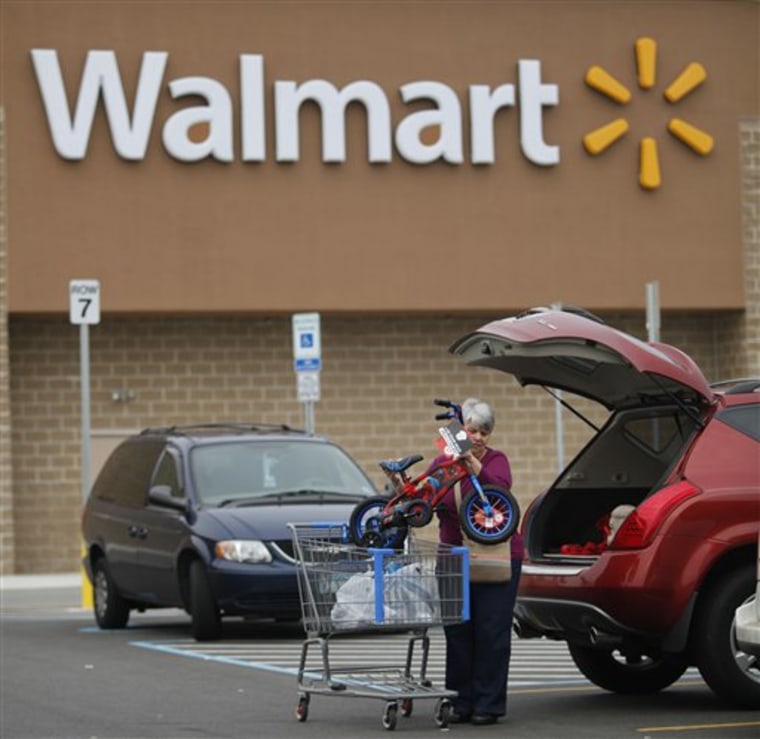Wal-Mart Stores Inc.'s first-quarter net income rose 10 percent as the world's largest retailer benefited from cost-cutting and robust growth in its international business.
But Wal-Mart said a key measure of revenue dropped for the fourth consecutive quarter as it continued to see a decline in customer counts at its U.S. namesake stores.
It also offered a muted outlook for the current quarter as shoppers worry about jobs and their finances.
Still, Wal-Mart's shares rose more than 2 percent, or $1.29, to $53.99 because results beat Wall Street expectations.
Wal-Mart said Tuesday net income was $3.32 billion, or 88 cents per share for the period ended April 30. That compares with $3.02 billion, or 77 cents per share in the same quarter last year.
Revenue rose almost 6 percent to $99.85 billion, from $94.24 billion.
Analysts surveyed by Thomson Reuters expected profit of 84 cents per share on revenue of $98.45 billion for the period.
Same-store sales drop
Revenue at stores open at least a year dropped 1.1 percent, dragged down by its U.S. namesake division. The measure is a key indicator of a retailer's health since it excludes the effect of expansion. Wall Street analysts had expected a 0.6 percent decline.
Wal-Mart, which generates more than $400 billion in sales annually, is considered a key barometer of consumer spending. The retailer's latest figures show that its shoppers are still struggling, with clothing sales the most disappointing.
"Our customers, particularly in the United States, are still concerned about their personal finances and unemployment, as well as higher fuel prices," Mike Duke, Wal-Mart's president and CEO, said in a statement.
During a conference call with the media Tuesday, Chief Financial Officer Tom Schoewe said that more than ever its customers are living "paycheck to paycheck." The number of customers on food stamps increased significantly, company officials said. And Schoewe noted sharpest increases it's seen in spending when paychecks or government payments are issued, indicating that people are waiting for those to spend.
Eduardo Castro-Wright, vice chairman of Wal-Mart who overseas its U.S. namesake business said that there was a 2 percentage point difference in revenue at stores with the lowest unemployment rate and the highest unemployment rate.
Wal-Mart benefited during the recession as affluent shoppers traded down to cheaper stores from mall-based stores. But Schoewe said there's a chance that stores have lost some of those customers, who are going back to the malls as the economy recovers. Still, he said higher gas prices, which he said have soared 40 percent from a year ago, have hurt customer traffic more.
In recent months, the discounter has also faced increasing competition from all types of retailers, which agressively lowered prices.
Wal-Mart, which in the fourth quarter had seen a decline in customer traffic and reported its first year-over-year quarterly drop in total revenue at U.S. Walmart stores since the company went public in 1969, stepped up its discounting in April.
The company announced Tuesday more price cutting across all grocery categories.
Schoewe told journalists that it's too early to tell whether those price cuts have attracted customers. The customer counts at its U.S. namesake stores declined, though the weakness was partially offset by an increase in the average transaction.
Fewer brands
Also hurting Walmart's U.S. stores was the company's move over the last year to offer fewer brands as part of a campaign to declutter its stores, company officials acknowledged during a prerecorded conference call. That has backfired and sent customers elsewhere.
Now, the company is adding some back. For example, Castro-Wright said the company is adding back 300 grocery products.
Walmart's U.S. division posted a 1.1 percent increase in revenue, while its international division enjoyed a 21.4 percent increase, boosted by strong business in China, Brazil and Mexico. Its Sams Club division had a 4.6 percent increase.
The company's revenue at stores open at least a year slipped 1.4 percent at its U.S. namesake stores, while the figure inched up 0.7 percent at its Sam's Clubs, excluding fuel sales. The company does not offer separate sales figures for the international division.
Wal-Mart said it expects revenue at stores open at least a year for its U.S. namesake business to be anywhere from down 2 percent to up 1 percent.
Wal-Mart expects earnings per share in the range of 93 cents to 98 cents per share for the second quarter. Analysts surveyed by Thomson Reuters projects 98 cents per share.
